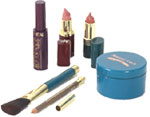Dear Umbra,
I haven’t been reading Grist for very long, so excuse me if you’ve already addressed this topic, but what are the environmental impacts of using cosmetics such as lipstick, eyeliner, mascara, eye shadow, and especially nail polish? Since becoming an environmentally conscious consumer, I have purchased cruelty-free products, but I have only recently begun to consider the environmental impact of the packaging and the products themselves. Are there products that are “all natural” and do not pose a threat to the environment? Where do all these chemicals in makeup come from (again, especially nail polish!) and what happens to them when they are tossed in the garbage (since most of the packaging is not recyclable)?
Celest
Parkville, Md.
Dearest Celest,
I have never addressed this topic, but thanks for checking. You can easily investigate the staleness of any question by scrolling to the bottom of this page, clicking “Archives,” clicking “Ask Umbra,” and then skimming through the list of issues addressed in past columns.

Hiss and makeup.
Discarded cosmetics and their fellow garbage are either consumed by burning, burning incinerator love or shmooshed in the landfill sandwich. The sundry ingredients of said cosmetics, when reduced to heat or ooze, may escape into the surrounding air, land, and water and attack the natural world with their potentially noxious properties (more on those below). The likelihood of escape depends on the security of the landfill (its lining, seals, and caps) or of the incinerator (its filters, scrubbers, and converters).
We beauty queens have little control over the afterlife of our cosmetics, so it is the consumption end that must absorb us. Unfortunately, inane and unnecessary packaging comes with the territory. Quite a variety of “natural” cosmetics grace the shelves of my food co-op, but none are available in bulk and I can’t see economy-size lipstick arriving any time soon. Some bright spots: Refills are par for the course with eye shadow, MAC cosmetics accepts old makeup containers with a return-six-get-a-lipstick-free policy, eyeliner can be used down to the nub, and mascara … seems like the tube could just be refilled at the local tar shop.
Now, as for what’s in makeup: Most cosmetics include a fragrance manufactured from volatile organic compounds, which can cause allergic reactions and may damage the nervous system. Chemical solvents, which keep substances liquid or help them dry quickly or make ingredients combine easily, are likewise an important component of modern cosmetics and are likewise to be avoided. And the manufacture of solvents and fragrances is not just a problem for you — it’s also bad news for plant employees and the waste stream. Less harmful cosmetics contain fewer solvents and VOCs, and will tout said accomplishment on the packaging.
Nail polish is in a class by itself. There is no purely nontoxic nail polish, although some brands claim the title by reducing the volatile compounds and fragrances in the polish. Trouble is, you’ve got to get that stuff off your nails somehow, and we all know that stinky, eye-irritating acetone is the best solution. If you are willing to give up one beauty product, make it nail polish. At least, paint your nails less frequently and in a well-ventilated room, and stay away from the nail salon, where the fumes mix with foot shavings in a frightening cocktail.
As for buying “natural” cosmetics, just be sure you read the fine print and read between the lines. Shop for these beauty amenities at fine purveyors of bleeding-heart, animal- and nature-loving products, and look for those sometimes meaningless but occasionally helpful terms and phrases such as “earth-friendly,” “nontoxic,” “no harmful fragrances,” etc. Or search the web using these terms and see what products turn up. (I am not going to promote any particular brands here.)
The bottom line: Cosmetics are bad for your personal environment, although their purported function is to improve said personal environment. And items that are toxic to the user are frequently toxic to the maker — and toxic to the waste stream when you’re done with them. Cut down on the toxics and you’ll be doing everyone upstream and downstream on the makeup river a favor.
Prettily,
Umbra


